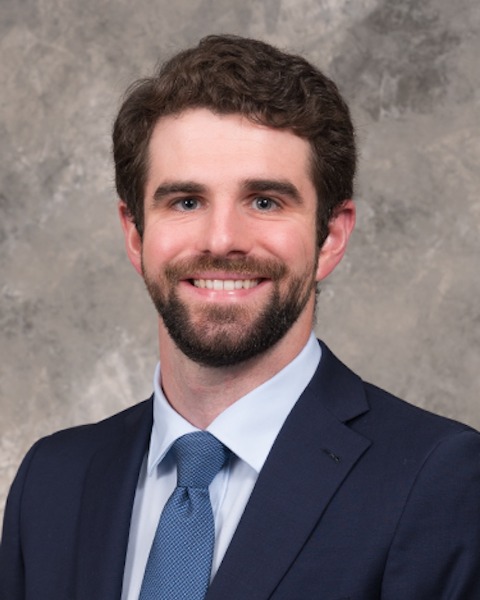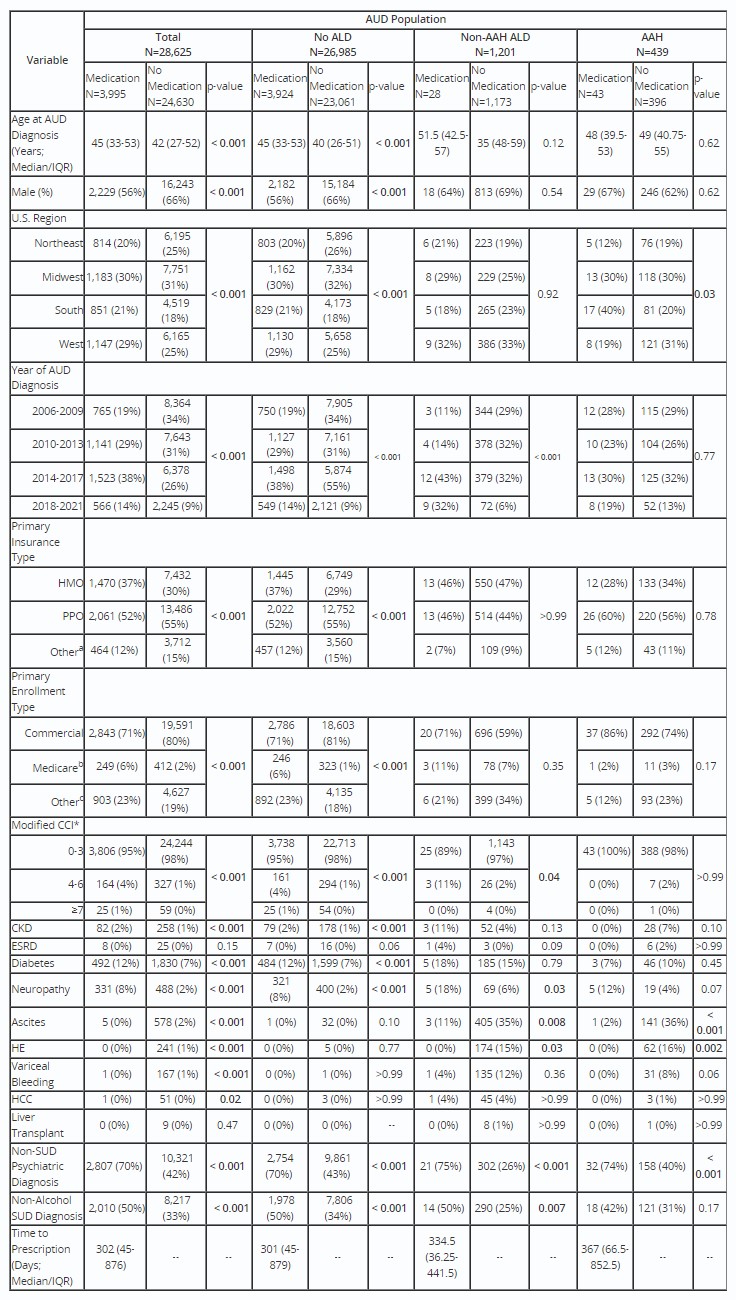Back
Oral Paper Presentation
Annual Scientific Meeting
Session: Plenary Session 2A - Small Intestine / Functional / Liver
23 - Pharmacologic Therapy for Alcohol Use Disorder Is Under-Utilized in Alcohol-Associated Liver Disease Among Commercially Insured U.S. Adults
Tuesday, October 29, 2024
9:10 AM – 9:20 AM ET
Location: Terrace Ballroom 1

Alex R. Jones, MD
University of Texas Southwestern Medical Center
Dallas, TX
Presenting Author(s)
Alex R. Jones, MD1, Yue Jiang, PhD2, Meena M. Tadros, BS1, Olgert Bardhi, MD1, Prajwal Gowda, BS1, Madhukar Patel, MD, MBA1, Ben Lippe, PhD1, Van Ngo, PharmD3, Mary Olumesi, PharmD1, Raelene Trudeau, PharmD1, Jessica Whitt, PharmD1, Layne Jordan, MD1, Alvaro Noriega Ramirez, BS1, Akhil Shenoy, MD4, Arjmand Mufti, MD1, Thomas Cotter, MD1, Mack Mitchell, MD1, Lisa B. VanWagner, MD, MSc1, Amit G. Singal, MD, MS5, Sarah R. Lieber, MD, MSCR1
1University of Texas Southwestern Medical Center, Dallas, TX; 2Duke University, Chapel Hill, NC; 3University of Texas Southwestern Medical Center, Dallas, UT; 4Columbia University Irving Medical Center, New York, NY; 5University of Texas Southwestern, Dallas, TX
Introduction: Alcohol use disorder (AUD) is present in over half of patients with alcohol-associated liver disease (ALD). Treatment of AUD in ALD reduces morbidity and mortality—pharmacotherapy is an important modality for treating addiction and preventing progression of liver disease. We aimed to characterize pharmacologic treatment patterns and factors associated with pharmacologic therapy among AUD patients with and without liver disease including acute alcoholic hepatitis (AAH).
Methods: Adult patients with AUD were identified from 2006-2021 using IQVIA PharMetrics® Plus for Academics, a nationally representative database of commercially insured Americans. The primary outcome was receipt of AUD pharmacologic therapy any time after index AUD diagnosis. We used multivariable logistic regression to identify factors associated with receipt of AUD pharmacotherapy.
Results: We identified a total of 28,625 patients with AUD: 26,985 without ALD, 1,201 with ALD, and 439 with AAH (Table 1); pharmacologic therapy was prescribed in 3,924 (14.5%) of patients without ALD, 28 (2.3%) with ALD, and 43 (9.8%) with AAH. One-time prescriptions were seen in 1,113 (28.4%) of the non-ALD, 3 (10.7%) of the ALD, and 8 (18.6%) of the AAH patients. The median time to prescription was 302 (IQR 45-876) days with no significant difference based on presence of liver disease (Table 1, p=0.51). Gabapentin was the most commonly prescribed medication (9.4%) followed by oral naltrexone (2.6%) and topiramate (2.1%). In a multivariable logistic regression model, age ≥50 years (aOR 1.33, 95% CI [1.23, 1.43]), female sex (aOR 1.31, 95% CI [1.22, 1.41]), non-liver Charlson Comorbdity Index ≥3 (aOR 2.21, 95% CI [1.80, 2.71]), and psychiatric comorbidity (aOR 2.76, 95% CI [2.56, 2.98]) were associated with receipt of pharmacotherapy. Presence of hepatic decompensation (ascites, hepatic encephalopathy, or bleeding varices) (aOR 0.08 95% CI [0.03, 0.17]) and non-AAH ALD (aOR 0.24, 95% CI [0.16, 0.35]) were associated with lower odds of receiving pharmacotherapy.
Discussion: In a large nationally representative cohort of commercially insured patients, AUD pharmacotherapy was underutilized in at risk populations, especially patients with ALD, among whom just 1 in 50 received AUD therapy. Providers caring for patients with ALD should consider this underutilized therapy, or refer for psychiatric consultation when appropriate.

Disclosures:
Alex R. Jones, MD1, Yue Jiang, PhD2, Meena M. Tadros, BS1, Olgert Bardhi, MD1, Prajwal Gowda, BS1, Madhukar Patel, MD, MBA1, Ben Lippe, PhD1, Van Ngo, PharmD3, Mary Olumesi, PharmD1, Raelene Trudeau, PharmD1, Jessica Whitt, PharmD1, Layne Jordan, MD1, Alvaro Noriega Ramirez, BS1, Akhil Shenoy, MD4, Arjmand Mufti, MD1, Thomas Cotter, MD1, Mack Mitchell, MD1, Lisa B. VanWagner, MD, MSc1, Amit G. Singal, MD, MS5, Sarah R. Lieber, MD, MSCR1, 23, Pharmacologic Therapy for Alcohol Use Disorder Is Under-Utilized in Alcohol-Associated Liver Disease Among Commercially Insured U.S. Adults, ACG 2024 Annual Scientific Meeting Abstracts. Philadelphia, PA: American College of Gastroenterology.
1University of Texas Southwestern Medical Center, Dallas, TX; 2Duke University, Chapel Hill, NC; 3University of Texas Southwestern Medical Center, Dallas, UT; 4Columbia University Irving Medical Center, New York, NY; 5University of Texas Southwestern, Dallas, TX
Introduction: Alcohol use disorder (AUD) is present in over half of patients with alcohol-associated liver disease (ALD). Treatment of AUD in ALD reduces morbidity and mortality—pharmacotherapy is an important modality for treating addiction and preventing progression of liver disease. We aimed to characterize pharmacologic treatment patterns and factors associated with pharmacologic therapy among AUD patients with and without liver disease including acute alcoholic hepatitis (AAH).
Methods: Adult patients with AUD were identified from 2006-2021 using IQVIA PharMetrics® Plus for Academics, a nationally representative database of commercially insured Americans. The primary outcome was receipt of AUD pharmacologic therapy any time after index AUD diagnosis. We used multivariable logistic regression to identify factors associated with receipt of AUD pharmacotherapy.
Results: We identified a total of 28,625 patients with AUD: 26,985 without ALD, 1,201 with ALD, and 439 with AAH (Table 1); pharmacologic therapy was prescribed in 3,924 (14.5%) of patients without ALD, 28 (2.3%) with ALD, and 43 (9.8%) with AAH. One-time prescriptions were seen in 1,113 (28.4%) of the non-ALD, 3 (10.7%) of the ALD, and 8 (18.6%) of the AAH patients. The median time to prescription was 302 (IQR 45-876) days with no significant difference based on presence of liver disease (Table 1, p=0.51). Gabapentin was the most commonly prescribed medication (9.4%) followed by oral naltrexone (2.6%) and topiramate (2.1%). In a multivariable logistic regression model, age ≥50 years (aOR 1.33, 95% CI [1.23, 1.43]), female sex (aOR 1.31, 95% CI [1.22, 1.41]), non-liver Charlson Comorbdity Index ≥3 (aOR 2.21, 95% CI [1.80, 2.71]), and psychiatric comorbidity (aOR 2.76, 95% CI [2.56, 2.98]) were associated with receipt of pharmacotherapy. Presence of hepatic decompensation (ascites, hepatic encephalopathy, or bleeding varices) (aOR 0.08 95% CI [0.03, 0.17]) and non-AAH ALD (aOR 0.24, 95% CI [0.16, 0.35]) were associated with lower odds of receiving pharmacotherapy.
Discussion: In a large nationally representative cohort of commercially insured patients, AUD pharmacotherapy was underutilized in at risk populations, especially patients with ALD, among whom just 1 in 50 received AUD therapy. Providers caring for patients with ALD should consider this underutilized therapy, or refer for psychiatric consultation when appropriate.

Table: Table 1. Sociodemographic and clinical characteristics of patients with alcohol use disorder stratified by no ALD, non-AAH ALD, or AAH (N=28,625). Abbreviations: Alcohol use disorder (AUD), alcohol-associated liver disease (ALD), acute alcoholic hepatitis (AAH), Health Maintenance Organization (HMO), Preferred Provider Organization (PPO), Charlson Comorbidity Index (CCI), chronic kidney disease (CKD), end-stage renal disease (ESRD), hepatic encephalopathy (HE), hepatocellular carcinoma (HCC), substance use disorder (SUD).
a "Other" includes indemnity / traditional, point of service, consumer directed health care, or health savings accounts (HSA)
b Advantage or supplemental plan
c "Other" includes State Children's Health Insurance Plan (SCHIP), Medicaid, or self-insured
* Excluding liver disease or severe liver disease from CCI calculation
a "Other" includes indemnity / traditional, point of service, consumer directed health care, or health savings accounts (HSA)
b Advantage or supplemental plan
c "Other" includes State Children's Health Insurance Plan (SCHIP), Medicaid, or self-insured
* Excluding liver disease or severe liver disease from CCI calculation
Disclosures:
Alex Jones indicated no relevant financial relationships.
Yue Jiang indicated no relevant financial relationships.
Meena Tadros indicated no relevant financial relationships.
Olgert Bardhi indicated no relevant financial relationships.
Prajwal Gowda indicated no relevant financial relationships.
Madhukar Patel indicated no relevant financial relationships.
Ben Lippe indicated no relevant financial relationships.
Van Ngo indicated no relevant financial relationships.
Mary Olumesi indicated no relevant financial relationships.
Raelene Trudeau indicated no relevant financial relationships.
Jessica Whitt indicated no relevant financial relationships.
Layne Jordan indicated no relevant financial relationships.
Alvaro Noriega Ramirez indicated no relevant financial relationships.
Akhil Shenoy indicated no relevant financial relationships.
Arjmand Mufti indicated no relevant financial relationships.
Thomas Cotter indicated no relevant financial relationships.
Mack Mitchell indicated no relevant financial relationships.
Lisa VanWagner: Gerson Lehrman Group – Consultant. Numares – Consultant. Slingshot Insights – Consultant. W.L. Gore & Associates – Grant/Research Support.
Amit Singal: AstraZeneca – Consultant. Bayer – Consultant. Boston Scientific – Consultant. Eisai – Consultant. Exact Sciences – Consultant. Exelixis – Consultant. Freenome – Consultant. FujiFilm Medical Sciences – Consultant. Genetech – Consultant. Glycotest – Consultant. GRAIL – Consultant. Roche – Consultant. TARGET RWE – Consultant.
Sarah Lieber indicated no relevant financial relationships.
Alex R. Jones, MD1, Yue Jiang, PhD2, Meena M. Tadros, BS1, Olgert Bardhi, MD1, Prajwal Gowda, BS1, Madhukar Patel, MD, MBA1, Ben Lippe, PhD1, Van Ngo, PharmD3, Mary Olumesi, PharmD1, Raelene Trudeau, PharmD1, Jessica Whitt, PharmD1, Layne Jordan, MD1, Alvaro Noriega Ramirez, BS1, Akhil Shenoy, MD4, Arjmand Mufti, MD1, Thomas Cotter, MD1, Mack Mitchell, MD1, Lisa B. VanWagner, MD, MSc1, Amit G. Singal, MD, MS5, Sarah R. Lieber, MD, MSCR1, 23, Pharmacologic Therapy for Alcohol Use Disorder Is Under-Utilized in Alcohol-Associated Liver Disease Among Commercially Insured U.S. Adults, ACG 2024 Annual Scientific Meeting Abstracts. Philadelphia, PA: American College of Gastroenterology.

